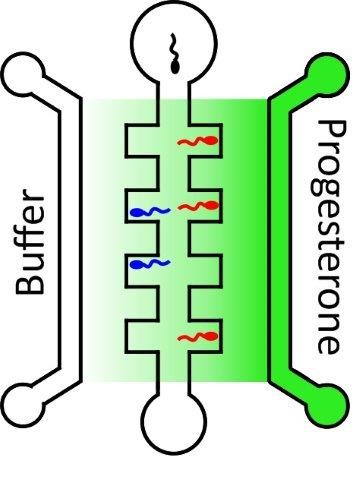
More sperm travel to the right side of a central channel, which contains high concentrations of progesterone (dark green), than to the left side, which contains lower concentrations (light green).
Sperm use chemotaxis, or movement toward increasing or decreasing concentrations of a substance, to guide their journey through the fallopian tube to the egg. Progesterone is present at high concentrations in the fluid that surrounds the egg, and previous studies have indicated that the hormone can attract and activate spermatozoa of some mammalian species. Scientists have used microfluidic devices — plastic or hydrogel chips with tiny channels through which liquids flow in a highly controlled manner —to study sperm chemotaxis. But the devices have had various limitations, such as the need for pumps to drive the flow of fluid, which could affect sperm motility. Loes Segerink, Johanna Berendsen and colleagues wanted to develop an improved, pump-free microfluidic device that could quickly identify small differences in the chemotactic behavior of sperm.
The researchers designed a microfluidic chip about the size of a postage stamp. The chip, which they made with an agarose/gelatin material, contained various channels and side chambers. The researchers created a concentration gradient of progesterone in the device from left to right, and saw that more boar spermatozoa added to the device swam to the right side chambers (high progesterone) than the left (low progesterone), which shows chemotactic movement. In addition to fertility testing, the device could be used to investigate other substances that could also contribute to sperm’s guidance mechanism, the researchers say.
acs.org


